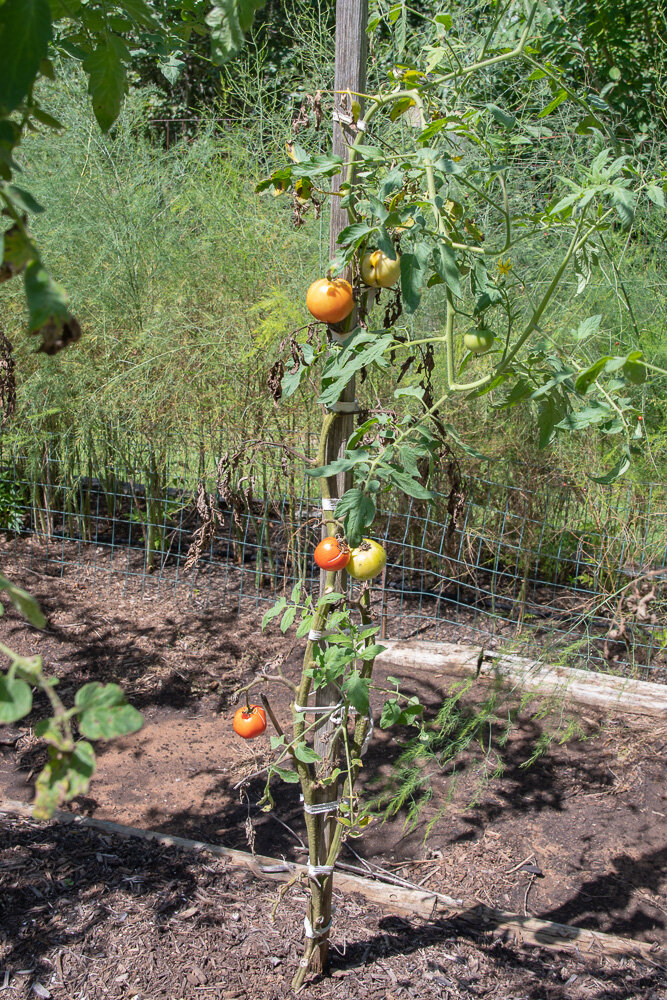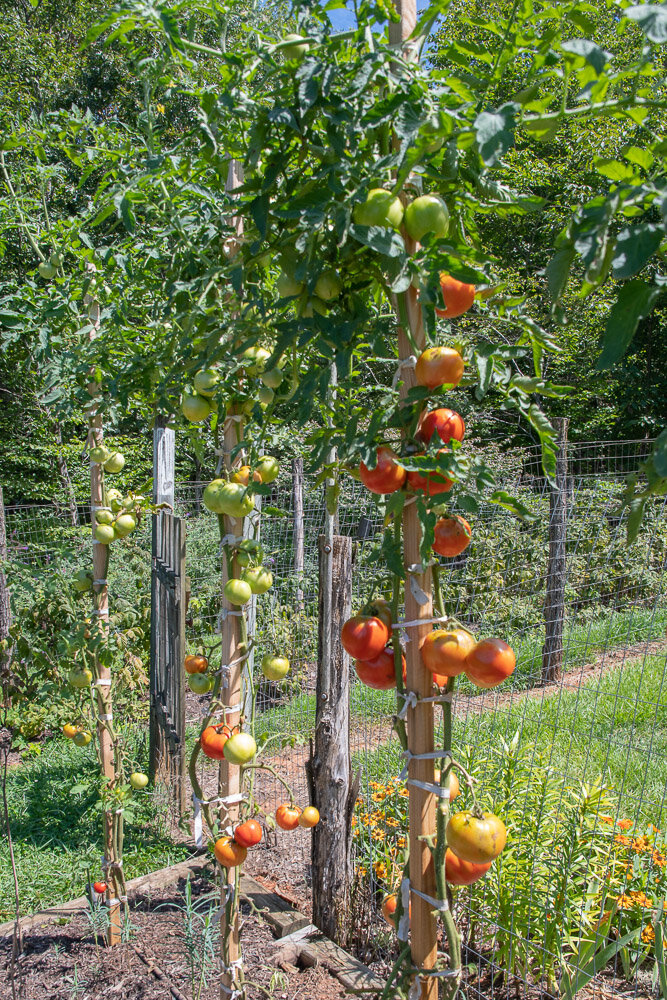by Mark Levisay
If you are not already asking yourself whether to pull out the tomato plants, then you will be later this month. Rolling into September, the days grow shorter, temperatures decrease (hopefully!) and the fungal tomato diseases really take off. Our recent heavy rains increase the trouble by causing many tomato skins to crack, increasing damage from both insects and disease. Let’s take a look at the plants and see which we can save and which we need to clear out.
Take a proactive approach to your tomato plants
Start by evaluating each plant to decide what action to take. Remember that every vegetable gardener in the region is dealing with the same thing. Staying ahead of fungal diseases is part of growing tomatoes in Central Virginia. (Blossom end rot is the only treatable condition on your tomato plants as it’s caused by insufficient watering as opposed to a disease.)
This sickly plant should probably be pulled.
If you’ve been watering during the dry spells, fertilizing monthly and trying to keep ahead of fungal diseases but you still have a plant that looks like the one above then it’s probably time to just pull it. This plant has few tomatoes and diseased leaves almost to the top. There’s not much you can do to help this plant become more productive, so remove it and all of the dead, diseased leaves from your garden. Put it in the trash or burn it—don’t throw it on the compost heap, especially if you intend to use that compost in your vegetable garden in the future. Think of the diseased leaves as contagious (they are) and treat them accordingly.
Healthy, productive tomato plant with diseased leaves removed.
With any luck your hard work will leave you with some tomato plants that look more like the one in the photo above. This plant still has lots of new, green growth at the top which, at least so far, has escaped infection from the myriad tomato diseases endemic in our gardens. There are lots of green and almost ripe tomatoes, so this plant has a lot of future potential. Continue to water when dry and remove any diseased leaves as they appear.
Make the most of ripening tomatoes
Healthy tomatoes still on the vine.
As fall approaches with cooler weather the tomatoes that are still on the plants will have a harder time ripening outdoors on the plants. Healthy tomatoes that are disease and crack-free like the ones in the photo above can be brought indoors for final ripening. If they’re almost ripe, just put them out on the counter and wait a few days. The tomatoes don’t need sun to ripen fully—warm temperatures (above 70F) are more important. It’s important that they’re dry, so don’t wash them until they’re ripe and ready to eat.
When our first frost (mid-October in central VA) threatens, you may want to pick a number of green tomatoes and ripen them indoors. Leave the stems on, which will aid the ripening. Large paper bags or a cardboard box can work for this, and you can add an apple or banana into the mix to increase the amount of ethylene gas present to promote the ripening process. Pick only the fully mature green tomatoes (uniform light green color) as the immature fruits (darker green upper shoulder) will never become fully ripe.
Diseased tomatoes need to be discarded.
If you find any tomatoes on your vines like the ones above, pick and discard them. Fruits that look like this will go bad before they’re ripe enough to eat. If you’re making something cooked like spaghetti sauce or salsa, you can peel ripe fruits with diseased skins and use them in your recipes. Their unsightly skin probably precludes their use in salads!
If the weather person predicts a frost, go ahead and pick your best remaining tomatoes. Keep them warm and out of direct sun and you should get a final batch of usable, though probably less tasty fruit. Check all picked tomatoes frequently, as any that start to go bad need to be removed from the others.
Even a minor frost will probably kill the tomato plants so go ahead and pull them as soon as it happens. It’s important to pick up any dead and diseased leaves as you are clearing out to minimize future problems in the garden.
Good luck with your late season tomatoes! Any questions please e-mail me at marklevisay@gmail.com.



